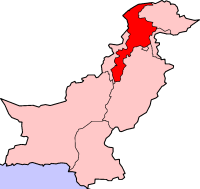Phallus calongei
| Phallus calongei | |
|---|---|

| |
| Scale bar=1 cm | |
| Scientific classification | |
| Domain: | Eukaryota |
| Kingdom: | Fungi |
| Division: | Basidiomycota |
| Class: | Agaricomycetes |
| Order: | Phallales |
| Family: | Phallaceae |
| Genus: | Phallus |
| Species: | P. calongei
|
| Binomial name | |
| Phallus calongei G. Moreno & Khalid
| |

| |
| Known only from Khyber Pakhtunkhwa (dark red), Pakistan | |
Phallus calongei is a species of
Systematics
Phallus calongei was discovered on June 16, 2008, near the
According to the infrageneric
Description
As a member of the genus Phallus, the shape of P. calongei mushrooms assume the general form of a phallus (an erect human penis) with a single elongated hollow stipe topped by a bulbous cap-like structure at the apex.[7] The fruit bodies of P. calongei start out appearing similar to whitish "eggs", with a membranous exoperidium (outer tissue layer) and gelatinous, translucent endoperidium (inner tissue layer). The exoperidium remains at the base of the fruit body as a thin, membranous, undeveloped white volva.
The fully expanded fruit body consists of a single, thick, stalk with a ridged and pitted cap attached to the apex; the cap is covered with olive-green, slimy gleba. The fruit body can reach up to 24 centimetres (9+1⁄2 inches) tall and 3 cm (1+1⁄8 in) thick. It is whitish and hollow, slightly tapered at both ends, and has a wall that consists of layers of perforated chambers. At the apex of the stalk is the "cap", which can be up to 7 cm (2+3⁄4 in) high and 4 cm (1+5⁄8 in) thick. It is bell-shaped to conical-truncate with a pitted surface. As the gleba dissipates, the cap surface becomes strongly reticulated—forming a network of raised pinkish ridges. The tip of the cap is truncated, with a depressed and perforated surface. The gleba is olive-green, fetid, and deliquescent (melting away gradually).
The spores are ellipsoid, smooth, and hyaline (translucent), measuring 3.5–4.5 by 1.5–2.0 µm. The edibility of the mushroom has not been determined.[5]
Similar species
The only other Phallus species known with a pinkish-colored cap is P. rubicundus; its conical cap has a surface that is wrinkled, not reticulate. Other similar species include P. hadriani, which has a purple volva, P. macrosporus, which has a reddish volva, and P. formanosus, which has a pale pink stipe and volva.[5]
Habitat and distribution
P. calongei is known only from the
References
- ISBN 978-3-443-65008-7.
- ^ Calonge FD, Kreisel H, Mata M (2005). "Phallus atrovolvatus, a new species from Costa Rica". Boletín de la Sociedad Micológica de Madrid. 29: 5–8.
- ^ Calonge FD, de Sequeira MM, Freitas T, Rocha E, Franquinho L (2008). "Phallus maderensis sp. nov., encontrado en Madeira, Portugal" [Phallus maderensis sp. nov., found in Madeira, Portugal] (PDF). Boletin de la Sociedad Micologica de Madrid. 32: 101–4.
- hdl:10261/91831.
- ^ doi:10.5248/108.457.
- ^ .
- ISBN 0-916422-74-7.
